South Africa's Health Care System: A Comparative Analysis Report
VerifiedAdded on 2020/02/24
|14
|3543
|118
Report
AI Summary
This report provides a comprehensive analysis of South Africa's healthcare system, starting with its historical context and evolution since the end of apartheid in 1994. It examines the roles of the South African government and non-governmental organizations (NGOs) in healthcare delivery, including their responsibilities in funding, providing services, and implementing policies like the National Health Insurance (NHI). The report evaluates the performance of South Africa's health system using the WHO framework, addressing health system building blocks, health delivery platforms, and overall health performance. It highlights challenges such as resource disparities, inefficiencies, and the need for improvements in various areas. The report also discusses health policies and initiatives, and future health system reforms, offering insights into the complexities and ongoing efforts to improve healthcare access and quality for all South Africans.
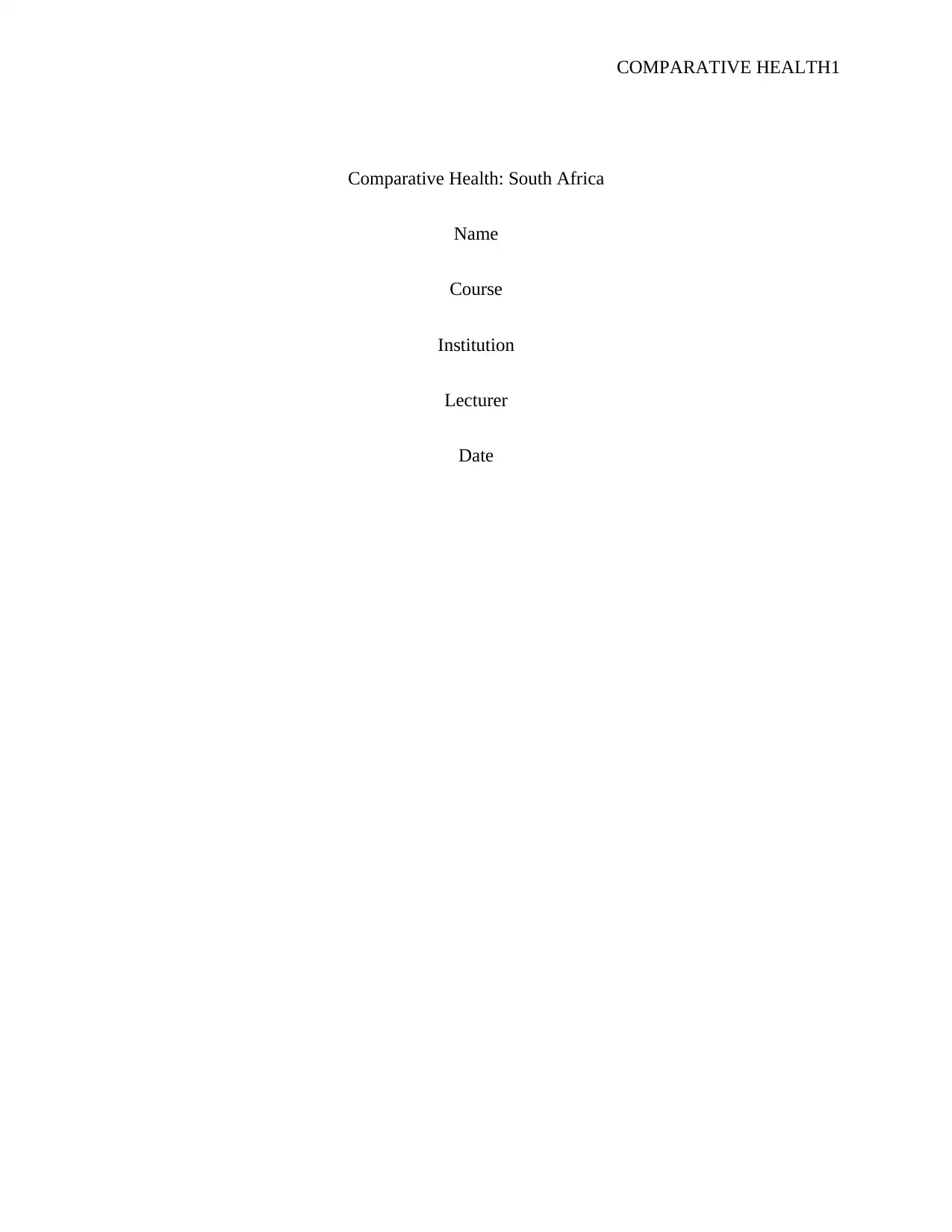
COMPARATIVE HEALTH1
Comparative Health: South Africa
Name
Course
Institution
Lecturer
Date
Comparative Health: South Africa
Name
Course
Institution
Lecturer
Date
Paraphrase This Document
Need a fresh take? Get an instant paraphrase of this document with our AI Paraphraser
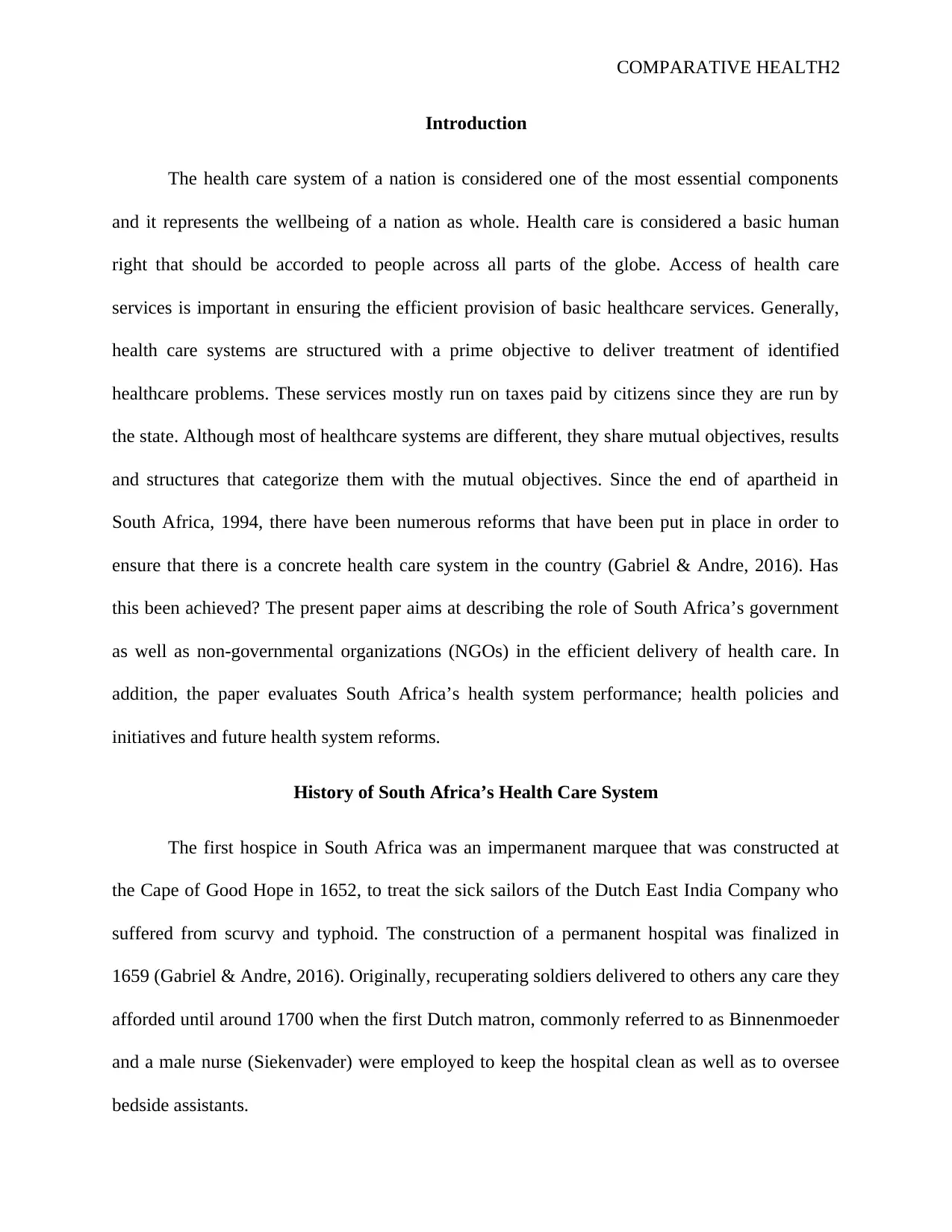
COMPARATIVE HEALTH2
Introduction
The health care system of a nation is considered one of the most essential components
and it represents the wellbeing of a nation as whole. Health care is considered a basic human
right that should be accorded to people across all parts of the globe. Access of health care
services is important in ensuring the efficient provision of basic healthcare services. Generally,
health care systems are structured with a prime objective to deliver treatment of identified
healthcare problems. These services mostly run on taxes paid by citizens since they are run by
the state. Although most of healthcare systems are different, they share mutual objectives, results
and structures that categorize them with the mutual objectives. Since the end of apartheid in
South Africa, 1994, there have been numerous reforms that have been put in place in order to
ensure that there is a concrete health care system in the country (Gabriel & Andre, 2016). Has
this been achieved? The present paper aims at describing the role of South Africa’s government
as well as non-governmental organizations (NGOs) in the efficient delivery of health care. In
addition, the paper evaluates South Africa’s health system performance; health policies and
initiatives and future health system reforms.
History of South Africa’s Health Care System
The first hospice in South Africa was an impermanent marquee that was constructed at
the Cape of Good Hope in 1652, to treat the sick sailors of the Dutch East India Company who
suffered from scurvy and typhoid. The construction of a permanent hospital was finalized in
1659 (Gabriel & Andre, 2016). Originally, recuperating soldiers delivered to others any care they
afforded until around 1700 when the first Dutch matron, commonly referred to as Binnenmoeder
and a male nurse (Siekenvader) were employed to keep the hospital clean as well as to oversee
bedside assistants.
Introduction
The health care system of a nation is considered one of the most essential components
and it represents the wellbeing of a nation as whole. Health care is considered a basic human
right that should be accorded to people across all parts of the globe. Access of health care
services is important in ensuring the efficient provision of basic healthcare services. Generally,
health care systems are structured with a prime objective to deliver treatment of identified
healthcare problems. These services mostly run on taxes paid by citizens since they are run by
the state. Although most of healthcare systems are different, they share mutual objectives, results
and structures that categorize them with the mutual objectives. Since the end of apartheid in
South Africa, 1994, there have been numerous reforms that have been put in place in order to
ensure that there is a concrete health care system in the country (Gabriel & Andre, 2016). Has
this been achieved? The present paper aims at describing the role of South Africa’s government
as well as non-governmental organizations (NGOs) in the efficient delivery of health care. In
addition, the paper evaluates South Africa’s health system performance; health policies and
initiatives and future health system reforms.
History of South Africa’s Health Care System
The first hospice in South Africa was an impermanent marquee that was constructed at
the Cape of Good Hope in 1652, to treat the sick sailors of the Dutch East India Company who
suffered from scurvy and typhoid. The construction of a permanent hospital was finalized in
1659 (Gabriel & Andre, 2016). Originally, recuperating soldiers delivered to others any care they
afforded until around 1700 when the first Dutch matron, commonly referred to as Binnenmoeder
and a male nurse (Siekenvader) were employed to keep the hospital clean as well as to oversee
bedside assistants.
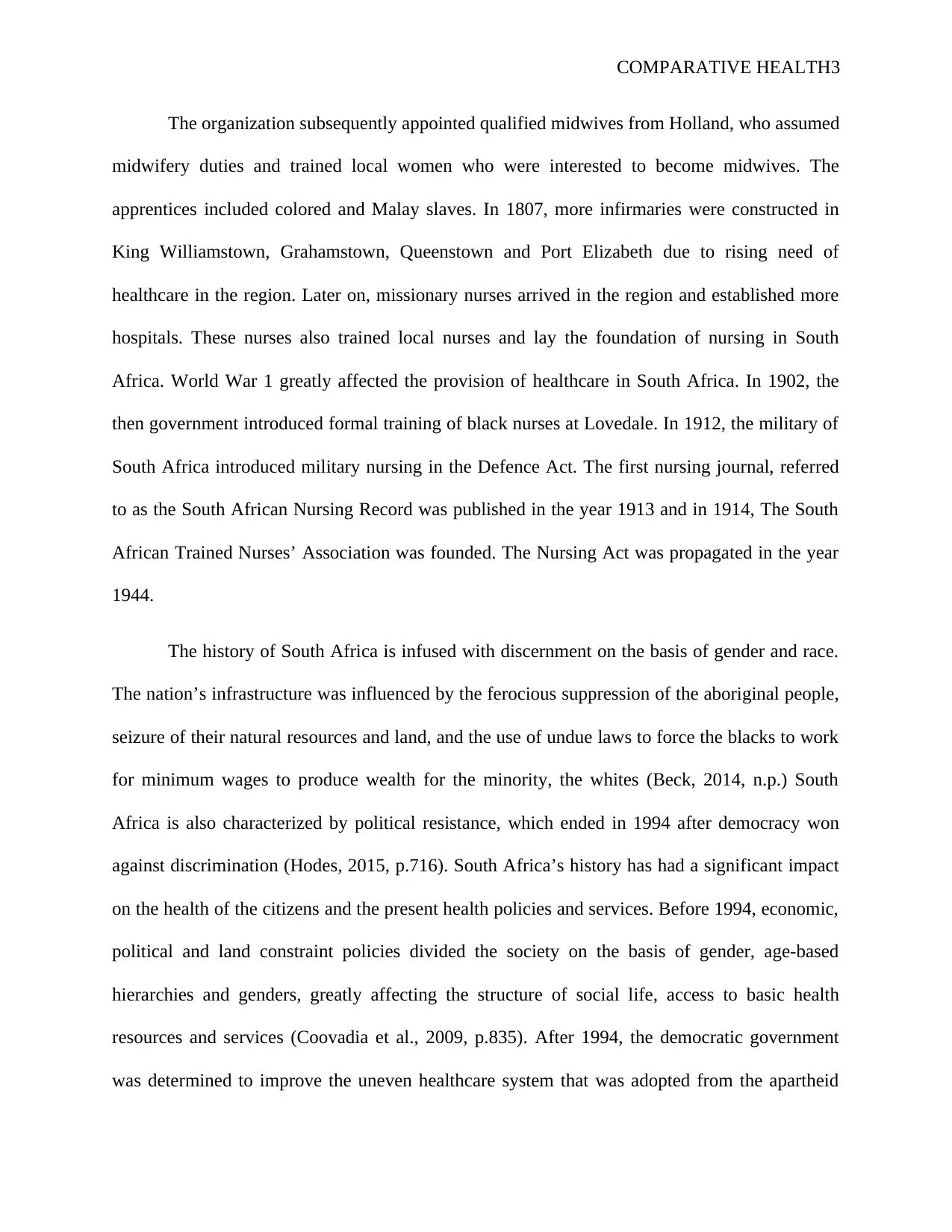
COMPARATIVE HEALTH3
The organization subsequently appointed qualified midwives from Holland, who assumed
midwifery duties and trained local women who were interested to become midwives. The
apprentices included colored and Malay slaves. In 1807, more infirmaries were constructed in
King Williamstown, Grahamstown, Queenstown and Port Elizabeth due to rising need of
healthcare in the region. Later on, missionary nurses arrived in the region and established more
hospitals. These nurses also trained local nurses and lay the foundation of nursing in South
Africa. World War 1 greatly affected the provision of healthcare in South Africa. In 1902, the
then government introduced formal training of black nurses at Lovedale. In 1912, the military of
South Africa introduced military nursing in the Defence Act. The first nursing journal, referred
to as the South African Nursing Record was published in the year 1913 and in 1914, The South
African Trained Nurses’ Association was founded. The Nursing Act was propagated in the year
1944.
The history of South Africa is infused with discernment on the basis of gender and race.
The nation’s infrastructure was influenced by the ferocious suppression of the aboriginal people,
seizure of their natural resources and land, and the use of undue laws to force the blacks to work
for minimum wages to produce wealth for the minority, the whites (Beck, 2014, n.p.) South
Africa is also characterized by political resistance, which ended in 1994 after democracy won
against discrimination (Hodes, 2015, p.716). South Africa’s history has had a significant impact
on the health of the citizens and the present health policies and services. Before 1994, economic,
political and land constraint policies divided the society on the basis of gender, age-based
hierarchies and genders, greatly affecting the structure of social life, access to basic health
resources and services (Coovadia et al., 2009, p.835). After 1994, the democratic government
was determined to improve the uneven healthcare system that was adopted from the apartheid
The organization subsequently appointed qualified midwives from Holland, who assumed
midwifery duties and trained local women who were interested to become midwives. The
apprentices included colored and Malay slaves. In 1807, more infirmaries were constructed in
King Williamstown, Grahamstown, Queenstown and Port Elizabeth due to rising need of
healthcare in the region. Later on, missionary nurses arrived in the region and established more
hospitals. These nurses also trained local nurses and lay the foundation of nursing in South
Africa. World War 1 greatly affected the provision of healthcare in South Africa. In 1902, the
then government introduced formal training of black nurses at Lovedale. In 1912, the military of
South Africa introduced military nursing in the Defence Act. The first nursing journal, referred
to as the South African Nursing Record was published in the year 1913 and in 1914, The South
African Trained Nurses’ Association was founded. The Nursing Act was propagated in the year
1944.
The history of South Africa is infused with discernment on the basis of gender and race.
The nation’s infrastructure was influenced by the ferocious suppression of the aboriginal people,
seizure of their natural resources and land, and the use of undue laws to force the blacks to work
for minimum wages to produce wealth for the minority, the whites (Beck, 2014, n.p.) South
Africa is also characterized by political resistance, which ended in 1994 after democracy won
against discrimination (Hodes, 2015, p.716). South Africa’s history has had a significant impact
on the health of the citizens and the present health policies and services. Before 1994, economic,
political and land constraint policies divided the society on the basis of gender, age-based
hierarchies and genders, greatly affecting the structure of social life, access to basic health
resources and services (Coovadia et al., 2009, p.835). After 1994, the democratic government
was determined to improve the uneven healthcare system that was adopted from the apartheid
⊘ This is a preview!⊘
Do you want full access?
Subscribe today to unlock all pages.

Trusted by 1+ million students worldwide
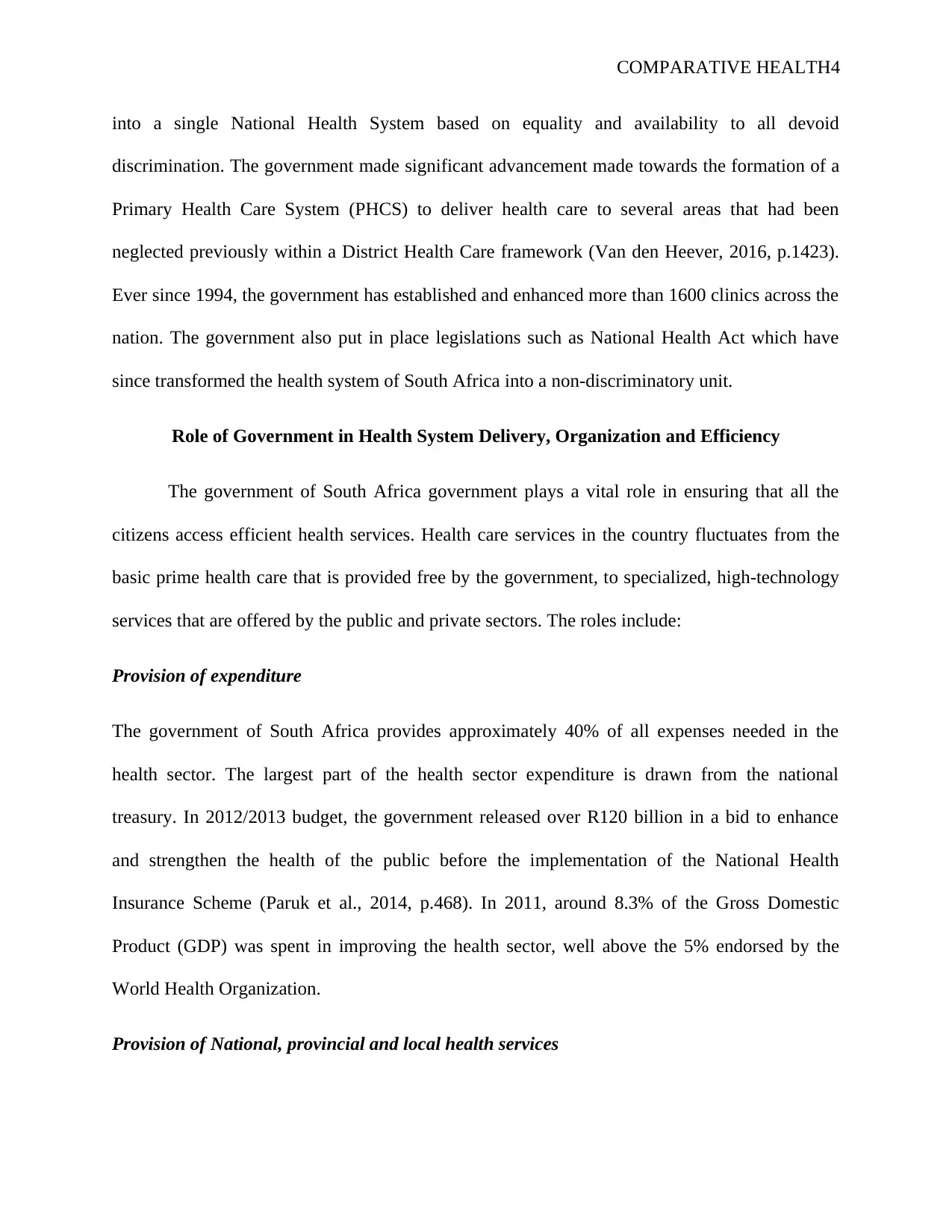
COMPARATIVE HEALTH4
into a single National Health System based on equality and availability to all devoid
discrimination. The government made significant advancement made towards the formation of a
Primary Health Care System (PHCS) to deliver health care to several areas that had been
neglected previously within a District Health Care framework (Van den Heever, 2016, p.1423).
Ever since 1994, the government has established and enhanced more than 1600 clinics across the
nation. The government also put in place legislations such as National Health Act which have
since transformed the health system of South Africa into a non-discriminatory unit.
Role of Government in Health System Delivery, Organization and Efficiency
The government of South Africa government plays a vital role in ensuring that all the
citizens access efficient health services. Health care services in the country fluctuates from the
basic prime health care that is provided free by the government, to specialized, high-technology
services that are offered by the public and private sectors. The roles include:
Provision of expenditure
The government of South Africa provides approximately 40% of all expenses needed in the
health sector. The largest part of the health sector expenditure is drawn from the national
treasury. In 2012/2013 budget, the government released over R120 billion in a bid to enhance
and strengthen the health of the public before the implementation of the National Health
Insurance Scheme (Paruk et al., 2014, p.468). In 2011, around 8.3% of the Gross Domestic
Product (GDP) was spent in improving the health sector, well above the 5% endorsed by the
World Health Organization.
Provision of National, provincial and local health services
into a single National Health System based on equality and availability to all devoid
discrimination. The government made significant advancement made towards the formation of a
Primary Health Care System (PHCS) to deliver health care to several areas that had been
neglected previously within a District Health Care framework (Van den Heever, 2016, p.1423).
Ever since 1994, the government has established and enhanced more than 1600 clinics across the
nation. The government also put in place legislations such as National Health Act which have
since transformed the health system of South Africa into a non-discriminatory unit.
Role of Government in Health System Delivery, Organization and Efficiency
The government of South Africa government plays a vital role in ensuring that all the
citizens access efficient health services. Health care services in the country fluctuates from the
basic prime health care that is provided free by the government, to specialized, high-technology
services that are offered by the public and private sectors. The roles include:
Provision of expenditure
The government of South Africa provides approximately 40% of all expenses needed in the
health sector. The largest part of the health sector expenditure is drawn from the national
treasury. In 2012/2013 budget, the government released over R120 billion in a bid to enhance
and strengthen the health of the public before the implementation of the National Health
Insurance Scheme (Paruk et al., 2014, p.468). In 2011, around 8.3% of the Gross Domestic
Product (GDP) was spent in improving the health sector, well above the 5% endorsed by the
World Health Organization.
Provision of National, provincial and local health services
Paraphrase This Document
Need a fresh take? Get an instant paraphrase of this document with our AI Paraphraser
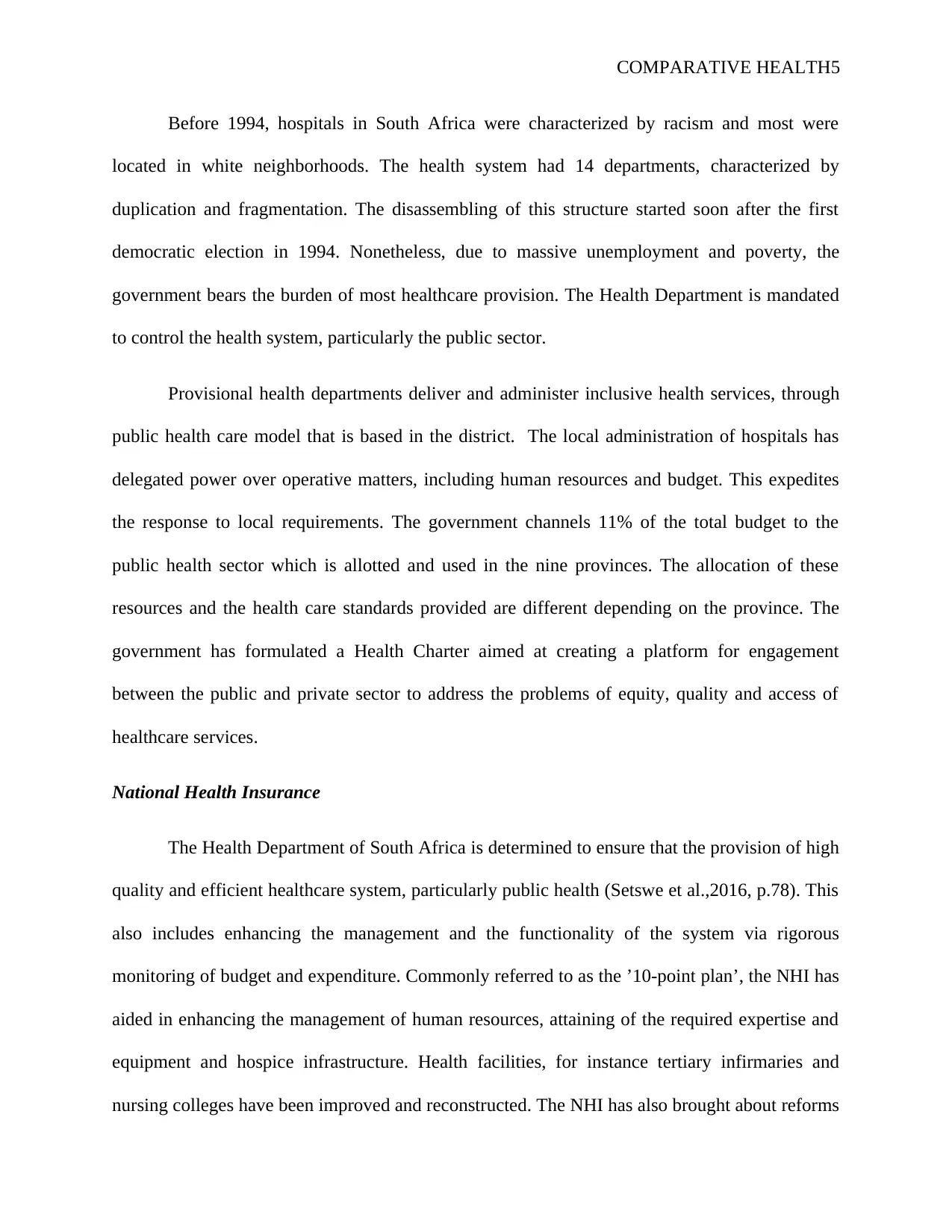
COMPARATIVE HEALTH5
Before 1994, hospitals in South Africa were characterized by racism and most were
located in white neighborhoods. The health system had 14 departments, characterized by
duplication and fragmentation. The disassembling of this structure started soon after the first
democratic election in 1994. Nonetheless, due to massive unemployment and poverty, the
government bears the burden of most healthcare provision. The Health Department is mandated
to control the health system, particularly the public sector.
Provisional health departments deliver and administer inclusive health services, through
public health care model that is based in the district. The local administration of hospitals has
delegated power over operative matters, including human resources and budget. This expedites
the response to local requirements. The government channels 11% of the total budget to the
public health sector which is allotted and used in the nine provinces. The allocation of these
resources and the health care standards provided are different depending on the province. The
government has formulated a Health Charter aimed at creating a platform for engagement
between the public and private sector to address the problems of equity, quality and access of
healthcare services.
National Health Insurance
The Health Department of South Africa is determined to ensure that the provision of high
quality and efficient healthcare system, particularly public health (Setswe et al.,2016, p.78). This
also includes enhancing the management and the functionality of the system via rigorous
monitoring of budget and expenditure. Commonly referred to as the ’10-point plan’, the NHI has
aided in enhancing the management of human resources, attaining of the required expertise and
equipment and hospice infrastructure. Health facilities, for instance tertiary infirmaries and
nursing colleges have been improved and reconstructed. The NHI has also brought about reforms
Before 1994, hospitals in South Africa were characterized by racism and most were
located in white neighborhoods. The health system had 14 departments, characterized by
duplication and fragmentation. The disassembling of this structure started soon after the first
democratic election in 1994. Nonetheless, due to massive unemployment and poverty, the
government bears the burden of most healthcare provision. The Health Department is mandated
to control the health system, particularly the public sector.
Provisional health departments deliver and administer inclusive health services, through
public health care model that is based in the district. The local administration of hospitals has
delegated power over operative matters, including human resources and budget. This expedites
the response to local requirements. The government channels 11% of the total budget to the
public health sector which is allotted and used in the nine provinces. The allocation of these
resources and the health care standards provided are different depending on the province. The
government has formulated a Health Charter aimed at creating a platform for engagement
between the public and private sector to address the problems of equity, quality and access of
healthcare services.
National Health Insurance
The Health Department of South Africa is determined to ensure that the provision of high
quality and efficient healthcare system, particularly public health (Setswe et al.,2016, p.78). This
also includes enhancing the management and the functionality of the system via rigorous
monitoring of budget and expenditure. Commonly referred to as the ’10-point plan’, the NHI has
aided in enhancing the management of human resources, attaining of the required expertise and
equipment and hospice infrastructure. Health facilities, for instance tertiary infirmaries and
nursing colleges have been improved and reconstructed. The NHI has also brought about reforms
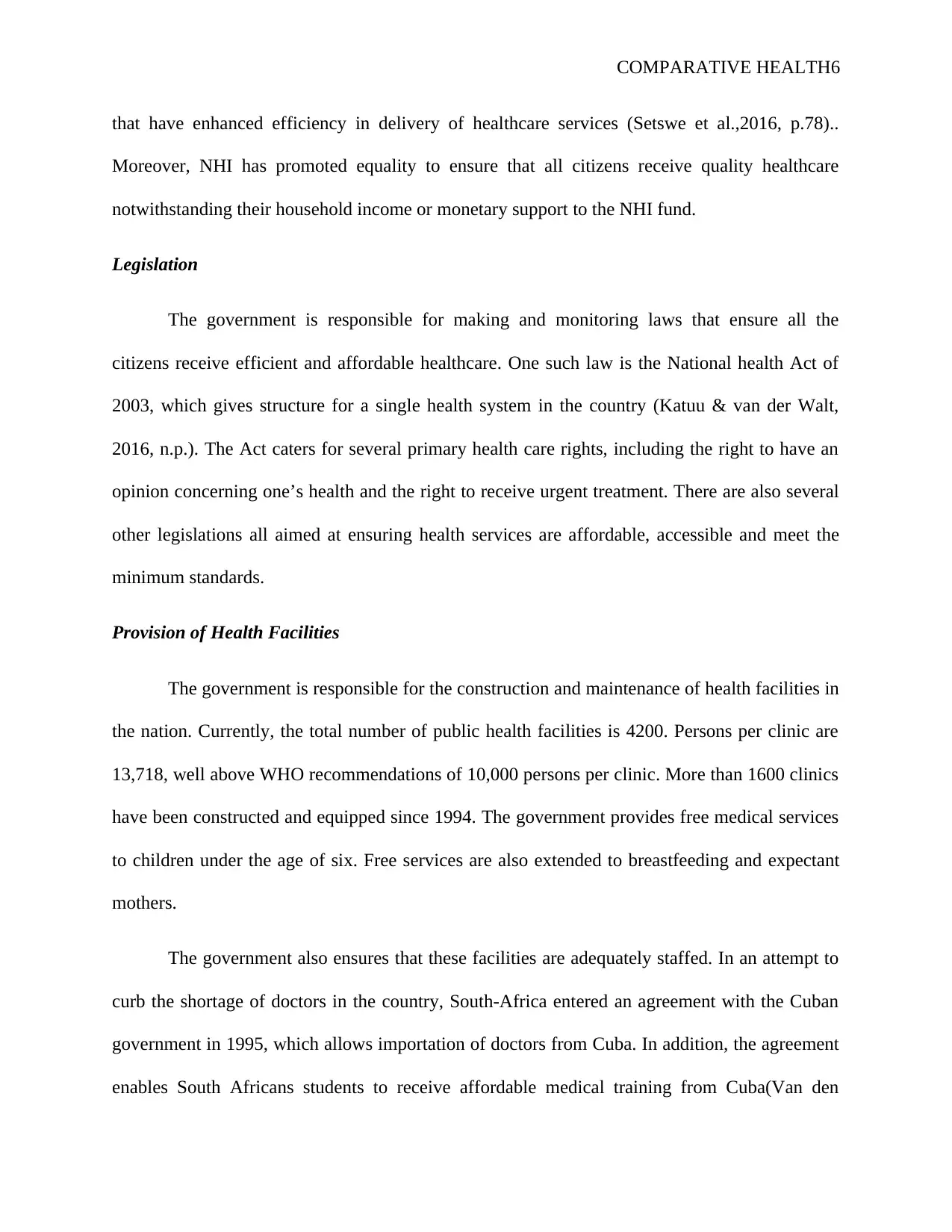
COMPARATIVE HEALTH6
that have enhanced efficiency in delivery of healthcare services (Setswe et al.,2016, p.78)..
Moreover, NHI has promoted equality to ensure that all citizens receive quality healthcare
notwithstanding their household income or monetary support to the NHI fund.
Legislation
The government is responsible for making and monitoring laws that ensure all the
citizens receive efficient and affordable healthcare. One such law is the National health Act of
2003, which gives structure for a single health system in the country (Katuu & van der Walt,
2016, n.p.). The Act caters for several primary health care rights, including the right to have an
opinion concerning one’s health and the right to receive urgent treatment. There are also several
other legislations all aimed at ensuring health services are affordable, accessible and meet the
minimum standards.
Provision of Health Facilities
The government is responsible for the construction and maintenance of health facilities in
the nation. Currently, the total number of public health facilities is 4200. Persons per clinic are
13,718, well above WHO recommendations of 10,000 persons per clinic. More than 1600 clinics
have been constructed and equipped since 1994. The government provides free medical services
to children under the age of six. Free services are also extended to breastfeeding and expectant
mothers.
The government also ensures that these facilities are adequately staffed. In an attempt to
curb the shortage of doctors in the country, South-Africa entered an agreement with the Cuban
government in 1995, which allows importation of doctors from Cuba. In addition, the agreement
enables South Africans students to receive affordable medical training from Cuba(Van den
that have enhanced efficiency in delivery of healthcare services (Setswe et al.,2016, p.78)..
Moreover, NHI has promoted equality to ensure that all citizens receive quality healthcare
notwithstanding their household income or monetary support to the NHI fund.
Legislation
The government is responsible for making and monitoring laws that ensure all the
citizens receive efficient and affordable healthcare. One such law is the National health Act of
2003, which gives structure for a single health system in the country (Katuu & van der Walt,
2016, n.p.). The Act caters for several primary health care rights, including the right to have an
opinion concerning one’s health and the right to receive urgent treatment. There are also several
other legislations all aimed at ensuring health services are affordable, accessible and meet the
minimum standards.
Provision of Health Facilities
The government is responsible for the construction and maintenance of health facilities in
the nation. Currently, the total number of public health facilities is 4200. Persons per clinic are
13,718, well above WHO recommendations of 10,000 persons per clinic. More than 1600 clinics
have been constructed and equipped since 1994. The government provides free medical services
to children under the age of six. Free services are also extended to breastfeeding and expectant
mothers.
The government also ensures that these facilities are adequately staffed. In an attempt to
curb the shortage of doctors in the country, South-Africa entered an agreement with the Cuban
government in 1995, which allows importation of doctors from Cuba. In addition, the agreement
enables South Africans students to receive affordable medical training from Cuba(Van den
⊘ This is a preview!⊘
Do you want full access?
Subscribe today to unlock all pages.

Trusted by 1+ million students worldwide
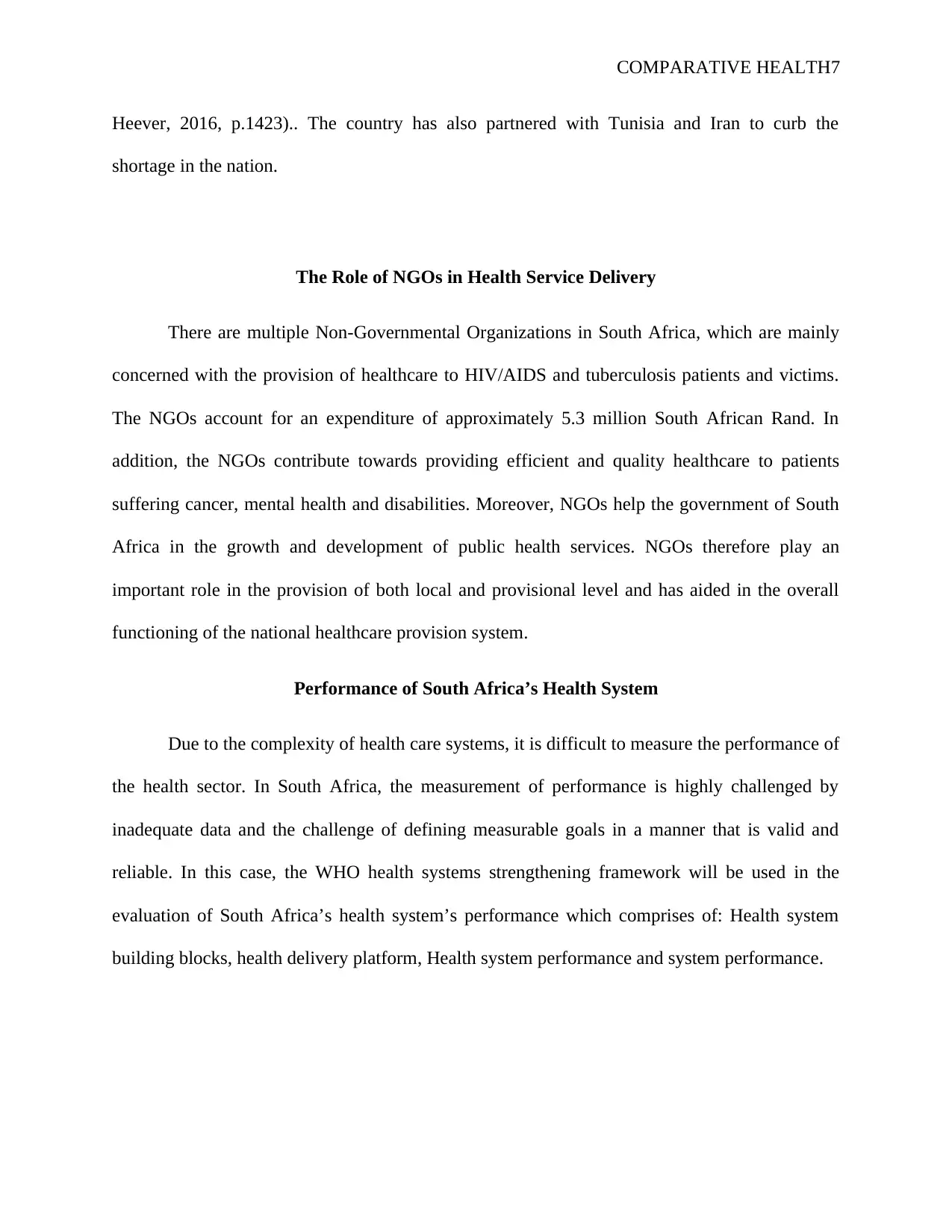
COMPARATIVE HEALTH7
Heever, 2016, p.1423).. The country has also partnered with Tunisia and Iran to curb the
shortage in the nation.
The Role of NGOs in Health Service Delivery
There are multiple Non-Governmental Organizations in South Africa, which are mainly
concerned with the provision of healthcare to HIV/AIDS and tuberculosis patients and victims.
The NGOs account for an expenditure of approximately 5.3 million South African Rand. In
addition, the NGOs contribute towards providing efficient and quality healthcare to patients
suffering cancer, mental health and disabilities. Moreover, NGOs help the government of South
Africa in the growth and development of public health services. NGOs therefore play an
important role in the provision of both local and provisional level and has aided in the overall
functioning of the national healthcare provision system.
Performance of South Africa’s Health System
Due to the complexity of health care systems, it is difficult to measure the performance of
the health sector. In South Africa, the measurement of performance is highly challenged by
inadequate data and the challenge of defining measurable goals in a manner that is valid and
reliable. In this case, the WHO health systems strengthening framework will be used in the
evaluation of South Africa’s health system’s performance which comprises of: Health system
building blocks, health delivery platform, Health system performance and system performance.
Heever, 2016, p.1423).. The country has also partnered with Tunisia and Iran to curb the
shortage in the nation.
The Role of NGOs in Health Service Delivery
There are multiple Non-Governmental Organizations in South Africa, which are mainly
concerned with the provision of healthcare to HIV/AIDS and tuberculosis patients and victims.
The NGOs account for an expenditure of approximately 5.3 million South African Rand. In
addition, the NGOs contribute towards providing efficient and quality healthcare to patients
suffering cancer, mental health and disabilities. Moreover, NGOs help the government of South
Africa in the growth and development of public health services. NGOs therefore play an
important role in the provision of both local and provisional level and has aided in the overall
functioning of the national healthcare provision system.
Performance of South Africa’s Health System
Due to the complexity of health care systems, it is difficult to measure the performance of
the health sector. In South Africa, the measurement of performance is highly challenged by
inadequate data and the challenge of defining measurable goals in a manner that is valid and
reliable. In this case, the WHO health systems strengthening framework will be used in the
evaluation of South Africa’s health system’s performance which comprises of: Health system
building blocks, health delivery platform, Health system performance and system performance.
Paraphrase This Document
Need a fresh take? Get an instant paraphrase of this document with our AI Paraphraser
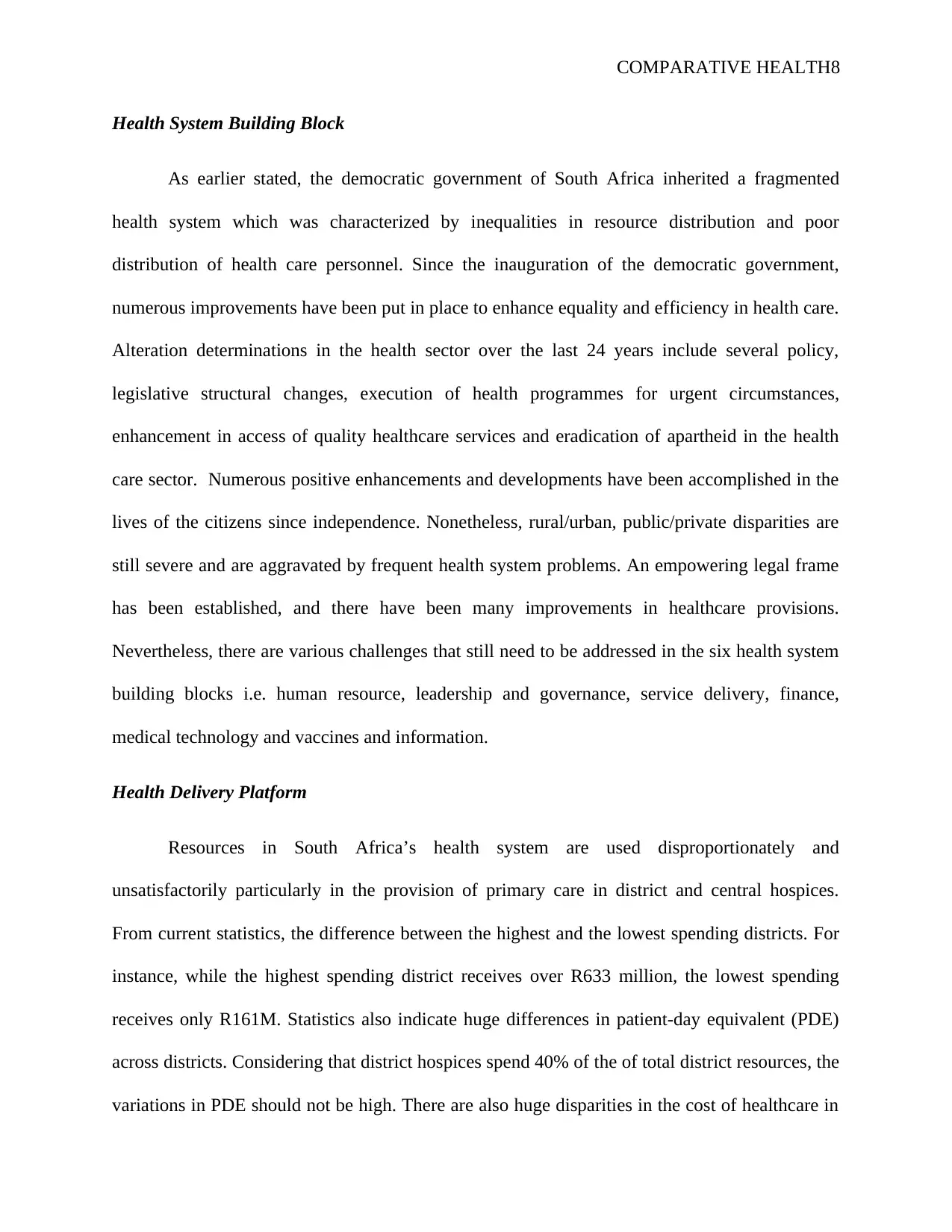
COMPARATIVE HEALTH8
Health System Building Block
As earlier stated, the democratic government of South Africa inherited a fragmented
health system which was characterized by inequalities in resource distribution and poor
distribution of health care personnel. Since the inauguration of the democratic government,
numerous improvements have been put in place to enhance equality and efficiency in health care.
Alteration determinations in the health sector over the last 24 years include several policy,
legislative structural changes, execution of health programmes for urgent circumstances,
enhancement in access of quality healthcare services and eradication of apartheid in the health
care sector. Numerous positive enhancements and developments have been accomplished in the
lives of the citizens since independence. Nonetheless, rural/urban, public/private disparities are
still severe and are aggravated by frequent health system problems. An empowering legal frame
has been established, and there have been many improvements in healthcare provisions.
Nevertheless, there are various challenges that still need to be addressed in the six health system
building blocks i.e. human resource, leadership and governance, service delivery, finance,
medical technology and vaccines and information.
Health Delivery Platform
Resources in South Africa’s health system are used disproportionately and
unsatisfactorily particularly in the provision of primary care in district and central hospices.
From current statistics, the difference between the highest and the lowest spending districts. For
instance, while the highest spending district receives over R633 million, the lowest spending
receives only R161M. Statistics also indicate huge differences in patient-day equivalent (PDE)
across districts. Considering that district hospices spend 40% of the of total district resources, the
variations in PDE should not be high. There are also huge disparities in the cost of healthcare in
Health System Building Block
As earlier stated, the democratic government of South Africa inherited a fragmented
health system which was characterized by inequalities in resource distribution and poor
distribution of health care personnel. Since the inauguration of the democratic government,
numerous improvements have been put in place to enhance equality and efficiency in health care.
Alteration determinations in the health sector over the last 24 years include several policy,
legislative structural changes, execution of health programmes for urgent circumstances,
enhancement in access of quality healthcare services and eradication of apartheid in the health
care sector. Numerous positive enhancements and developments have been accomplished in the
lives of the citizens since independence. Nonetheless, rural/urban, public/private disparities are
still severe and are aggravated by frequent health system problems. An empowering legal frame
has been established, and there have been many improvements in healthcare provisions.
Nevertheless, there are various challenges that still need to be addressed in the six health system
building blocks i.e. human resource, leadership and governance, service delivery, finance,
medical technology and vaccines and information.
Health Delivery Platform
Resources in South Africa’s health system are used disproportionately and
unsatisfactorily particularly in the provision of primary care in district and central hospices.
From current statistics, the difference between the highest and the lowest spending districts. For
instance, while the highest spending district receives over R633 million, the lowest spending
receives only R161M. Statistics also indicate huge differences in patient-day equivalent (PDE)
across districts. Considering that district hospices spend 40% of the of total district resources, the
variations in PDE should not be high. There are also huge disparities in the cost of healthcare in
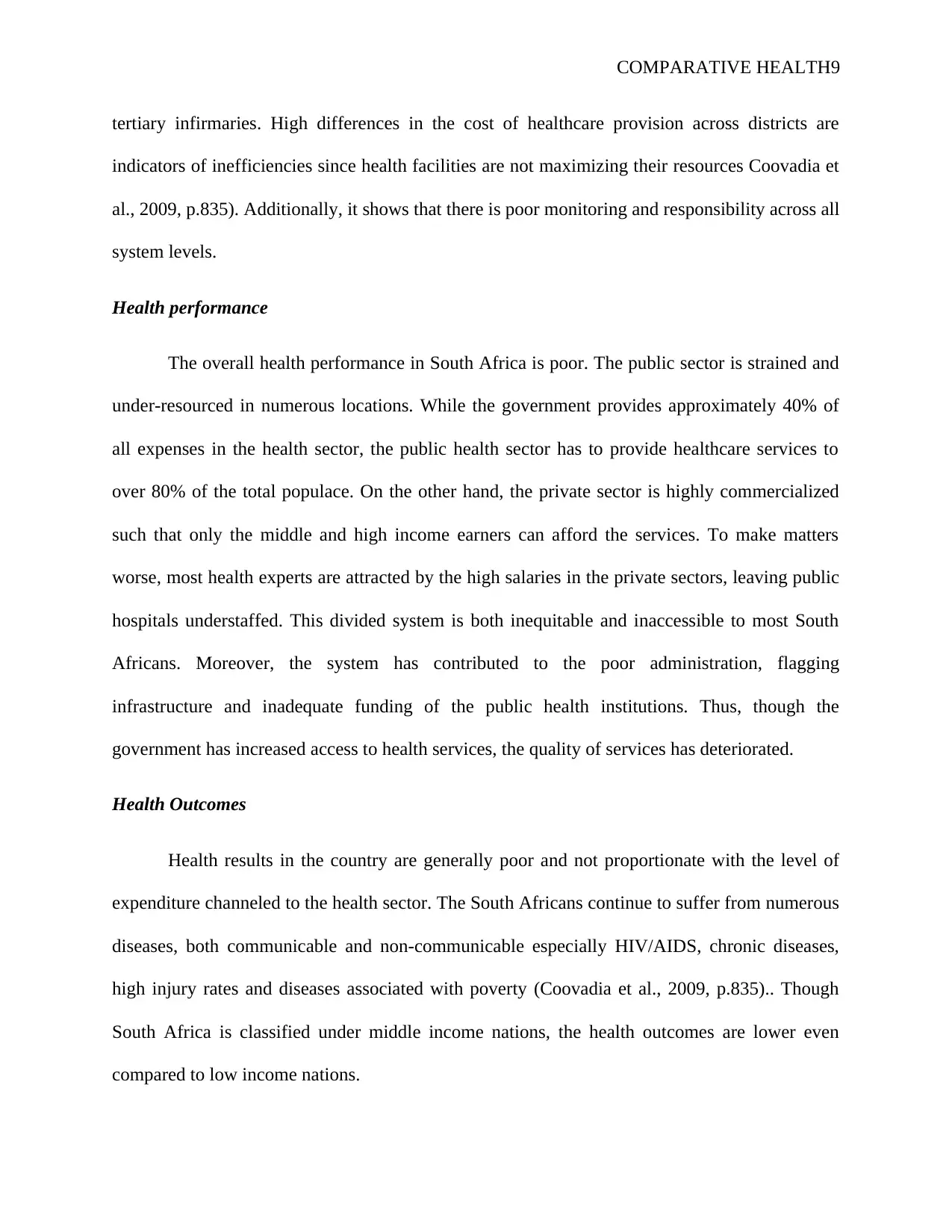
COMPARATIVE HEALTH9
tertiary infirmaries. High differences in the cost of healthcare provision across districts are
indicators of inefficiencies since health facilities are not maximizing their resources Coovadia et
al., 2009, p.835). Additionally, it shows that there is poor monitoring and responsibility across all
system levels.
Health performance
The overall health performance in South Africa is poor. The public sector is strained and
under-resourced in numerous locations. While the government provides approximately 40% of
all expenses in the health sector, the public health sector has to provide healthcare services to
over 80% of the total populace. On the other hand, the private sector is highly commercialized
such that only the middle and high income earners can afford the services. To make matters
worse, most health experts are attracted by the high salaries in the private sectors, leaving public
hospitals understaffed. This divided system is both inequitable and inaccessible to most South
Africans. Moreover, the system has contributed to the poor administration, flagging
infrastructure and inadequate funding of the public health institutions. Thus, though the
government has increased access to health services, the quality of services has deteriorated.
Health Outcomes
Health results in the country are generally poor and not proportionate with the level of
expenditure channeled to the health sector. The South Africans continue to suffer from numerous
diseases, both communicable and non-communicable especially HIV/AIDS, chronic diseases,
high injury rates and diseases associated with poverty (Coovadia et al., 2009, p.835).. Though
South Africa is classified under middle income nations, the health outcomes are lower even
compared to low income nations.
tertiary infirmaries. High differences in the cost of healthcare provision across districts are
indicators of inefficiencies since health facilities are not maximizing their resources Coovadia et
al., 2009, p.835). Additionally, it shows that there is poor monitoring and responsibility across all
system levels.
Health performance
The overall health performance in South Africa is poor. The public sector is strained and
under-resourced in numerous locations. While the government provides approximately 40% of
all expenses in the health sector, the public health sector has to provide healthcare services to
over 80% of the total populace. On the other hand, the private sector is highly commercialized
such that only the middle and high income earners can afford the services. To make matters
worse, most health experts are attracted by the high salaries in the private sectors, leaving public
hospitals understaffed. This divided system is both inequitable and inaccessible to most South
Africans. Moreover, the system has contributed to the poor administration, flagging
infrastructure and inadequate funding of the public health institutions. Thus, though the
government has increased access to health services, the quality of services has deteriorated.
Health Outcomes
Health results in the country are generally poor and not proportionate with the level of
expenditure channeled to the health sector. The South Africans continue to suffer from numerous
diseases, both communicable and non-communicable especially HIV/AIDS, chronic diseases,
high injury rates and diseases associated with poverty (Coovadia et al., 2009, p.835).. Though
South Africa is classified under middle income nations, the health outcomes are lower even
compared to low income nations.
⊘ This is a preview!⊘
Do you want full access?
Subscribe today to unlock all pages.

Trusted by 1+ million students worldwide
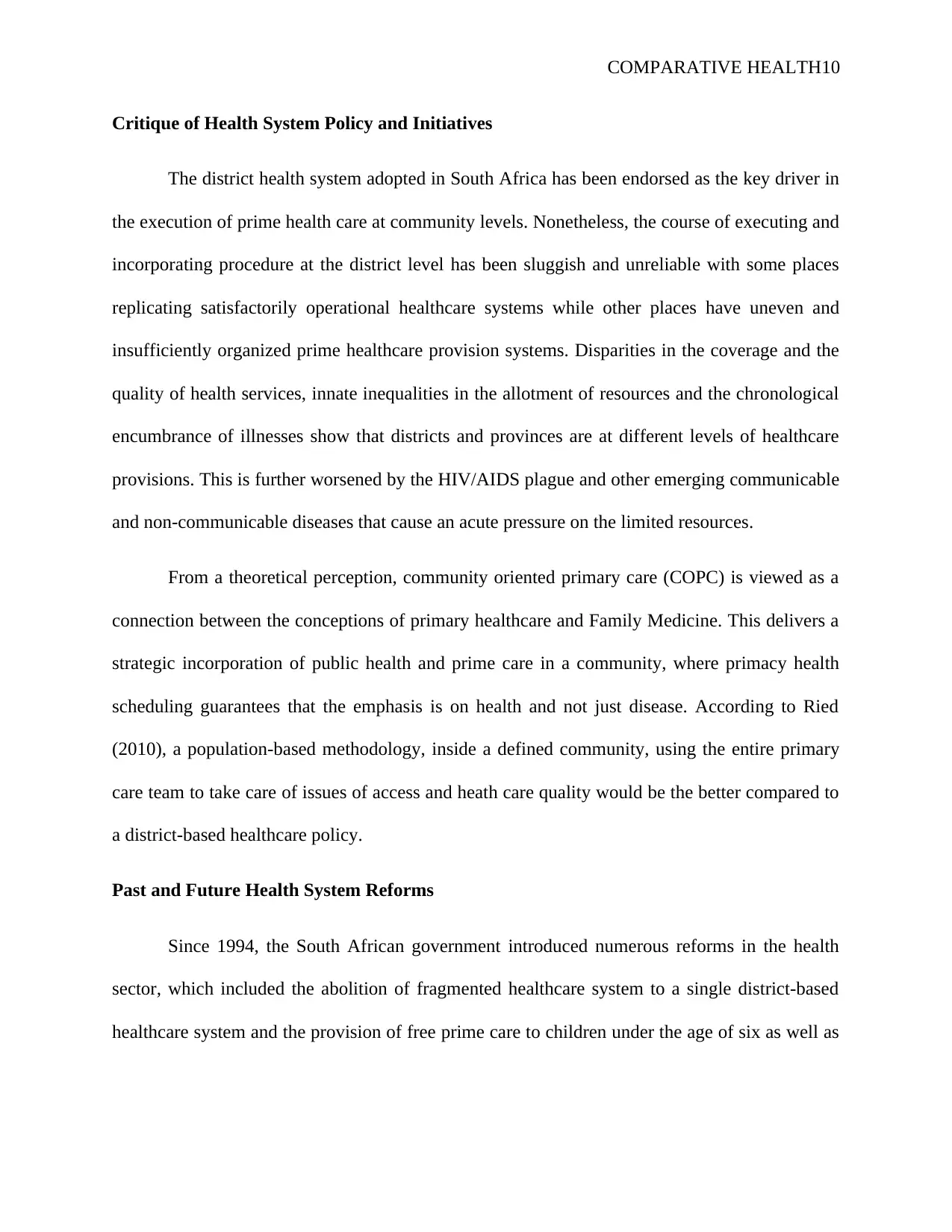
COMPARATIVE HEALTH10
Critique of Health System Policy and Initiatives
The district health system adopted in South Africa has been endorsed as the key driver in
the execution of prime health care at community levels. Nonetheless, the course of executing and
incorporating procedure at the district level has been sluggish and unreliable with some places
replicating satisfactorily operational healthcare systems while other places have uneven and
insufficiently organized prime healthcare provision systems. Disparities in the coverage and the
quality of health services, innate inequalities in the allotment of resources and the chronological
encumbrance of illnesses show that districts and provinces are at different levels of healthcare
provisions. This is further worsened by the HIV/AIDS plague and other emerging communicable
and non-communicable diseases that cause an acute pressure on the limited resources.
From a theoretical perception, community oriented primary care (COPC) is viewed as a
connection between the conceptions of primary healthcare and Family Medicine. This delivers a
strategic incorporation of public health and prime care in a community, where primacy health
scheduling guarantees that the emphasis is on health and not just disease. According to Ried
(2010), a population-based methodology, inside a defined community, using the entire primary
care team to take care of issues of access and heath care quality would be the better compared to
a district-based healthcare policy.
Past and Future Health System Reforms
Since 1994, the South African government introduced numerous reforms in the health
sector, which included the abolition of fragmented healthcare system to a single district-based
healthcare system and the provision of free prime care to children under the age of six as well as
Critique of Health System Policy and Initiatives
The district health system adopted in South Africa has been endorsed as the key driver in
the execution of prime health care at community levels. Nonetheless, the course of executing and
incorporating procedure at the district level has been sluggish and unreliable with some places
replicating satisfactorily operational healthcare systems while other places have uneven and
insufficiently organized prime healthcare provision systems. Disparities in the coverage and the
quality of health services, innate inequalities in the allotment of resources and the chronological
encumbrance of illnesses show that districts and provinces are at different levels of healthcare
provisions. This is further worsened by the HIV/AIDS plague and other emerging communicable
and non-communicable diseases that cause an acute pressure on the limited resources.
From a theoretical perception, community oriented primary care (COPC) is viewed as a
connection between the conceptions of primary healthcare and Family Medicine. This delivers a
strategic incorporation of public health and prime care in a community, where primacy health
scheduling guarantees that the emphasis is on health and not just disease. According to Ried
(2010), a population-based methodology, inside a defined community, using the entire primary
care team to take care of issues of access and heath care quality would be the better compared to
a district-based healthcare policy.
Past and Future Health System Reforms
Since 1994, the South African government introduced numerous reforms in the health
sector, which included the abolition of fragmented healthcare system to a single district-based
healthcare system and the provision of free prime care to children under the age of six as well as
Paraphrase This Document
Need a fresh take? Get an instant paraphrase of this document with our AI Paraphraser
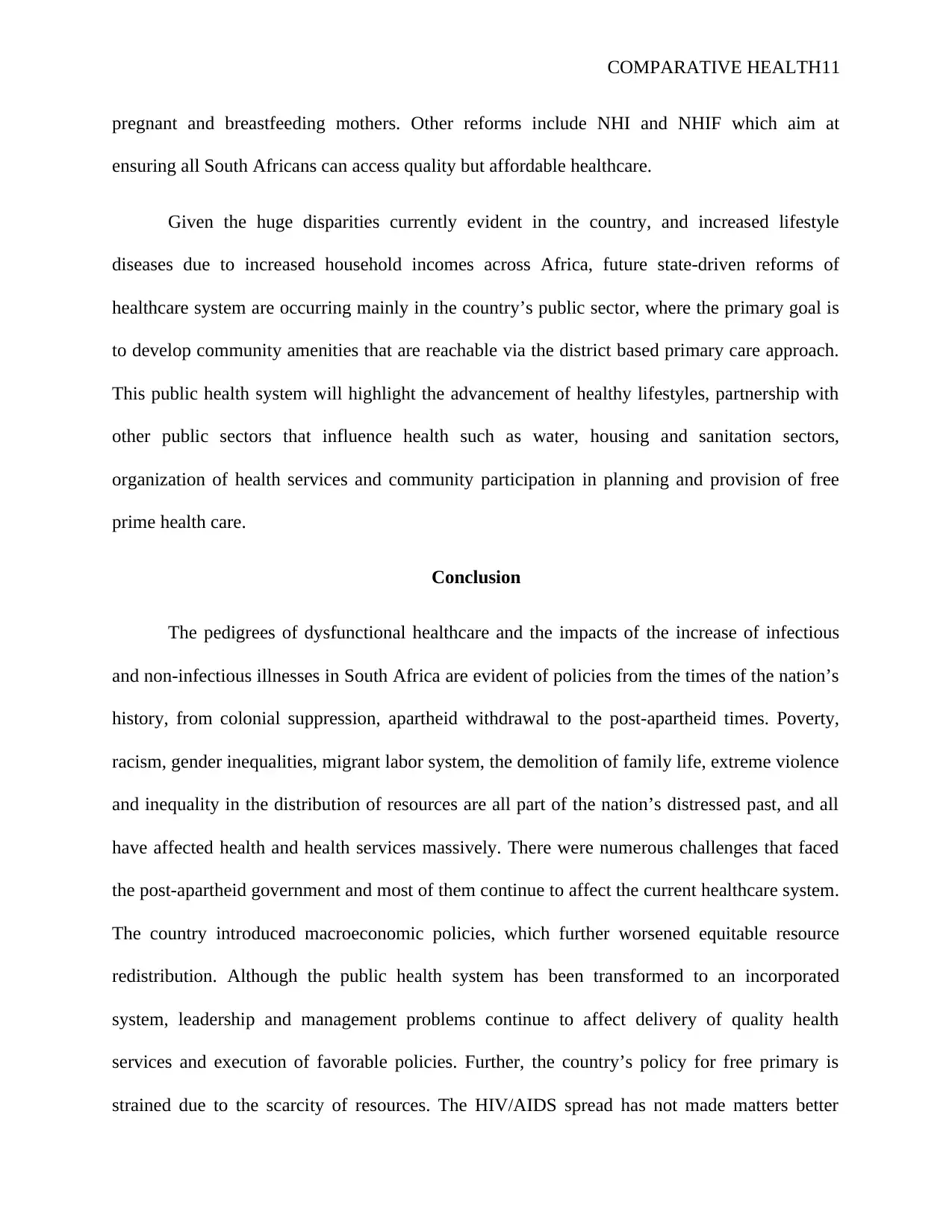
COMPARATIVE HEALTH11
pregnant and breastfeeding mothers. Other reforms include NHI and NHIF which aim at
ensuring all South Africans can access quality but affordable healthcare.
Given the huge disparities currently evident in the country, and increased lifestyle
diseases due to increased household incomes across Africa, future state-driven reforms of
healthcare system are occurring mainly in the country’s public sector, where the primary goal is
to develop community amenities that are reachable via the district based primary care approach.
This public health system will highlight the advancement of healthy lifestyles, partnership with
other public sectors that influence health such as water, housing and sanitation sectors,
organization of health services and community participation in planning and provision of free
prime health care.
Conclusion
The pedigrees of dysfunctional healthcare and the impacts of the increase of infectious
and non-infectious illnesses in South Africa are evident of policies from the times of the nation’s
history, from colonial suppression, apartheid withdrawal to the post-apartheid times. Poverty,
racism, gender inequalities, migrant labor system, the demolition of family life, extreme violence
and inequality in the distribution of resources are all part of the nation’s distressed past, and all
have affected health and health services massively. There were numerous challenges that faced
the post-apartheid government and most of them continue to affect the current healthcare system.
The country introduced macroeconomic policies, which further worsened equitable resource
redistribution. Although the public health system has been transformed to an incorporated
system, leadership and management problems continue to affect delivery of quality health
services and execution of favorable policies. Further, the country’s policy for free primary is
strained due to the scarcity of resources. The HIV/AIDS spread has not made matters better
pregnant and breastfeeding mothers. Other reforms include NHI and NHIF which aim at
ensuring all South Africans can access quality but affordable healthcare.
Given the huge disparities currently evident in the country, and increased lifestyle
diseases due to increased household incomes across Africa, future state-driven reforms of
healthcare system are occurring mainly in the country’s public sector, where the primary goal is
to develop community amenities that are reachable via the district based primary care approach.
This public health system will highlight the advancement of healthy lifestyles, partnership with
other public sectors that influence health such as water, housing and sanitation sectors,
organization of health services and community participation in planning and provision of free
prime health care.
Conclusion
The pedigrees of dysfunctional healthcare and the impacts of the increase of infectious
and non-infectious illnesses in South Africa are evident of policies from the times of the nation’s
history, from colonial suppression, apartheid withdrawal to the post-apartheid times. Poverty,
racism, gender inequalities, migrant labor system, the demolition of family life, extreme violence
and inequality in the distribution of resources are all part of the nation’s distressed past, and all
have affected health and health services massively. There were numerous challenges that faced
the post-apartheid government and most of them continue to affect the current healthcare system.
The country introduced macroeconomic policies, which further worsened equitable resource
redistribution. Although the public health system has been transformed to an incorporated
system, leadership and management problems continue to affect delivery of quality health
services and execution of favorable policies. Further, the country’s policy for free primary is
strained due to the scarcity of resources. The HIV/AIDS spread has not made matters better
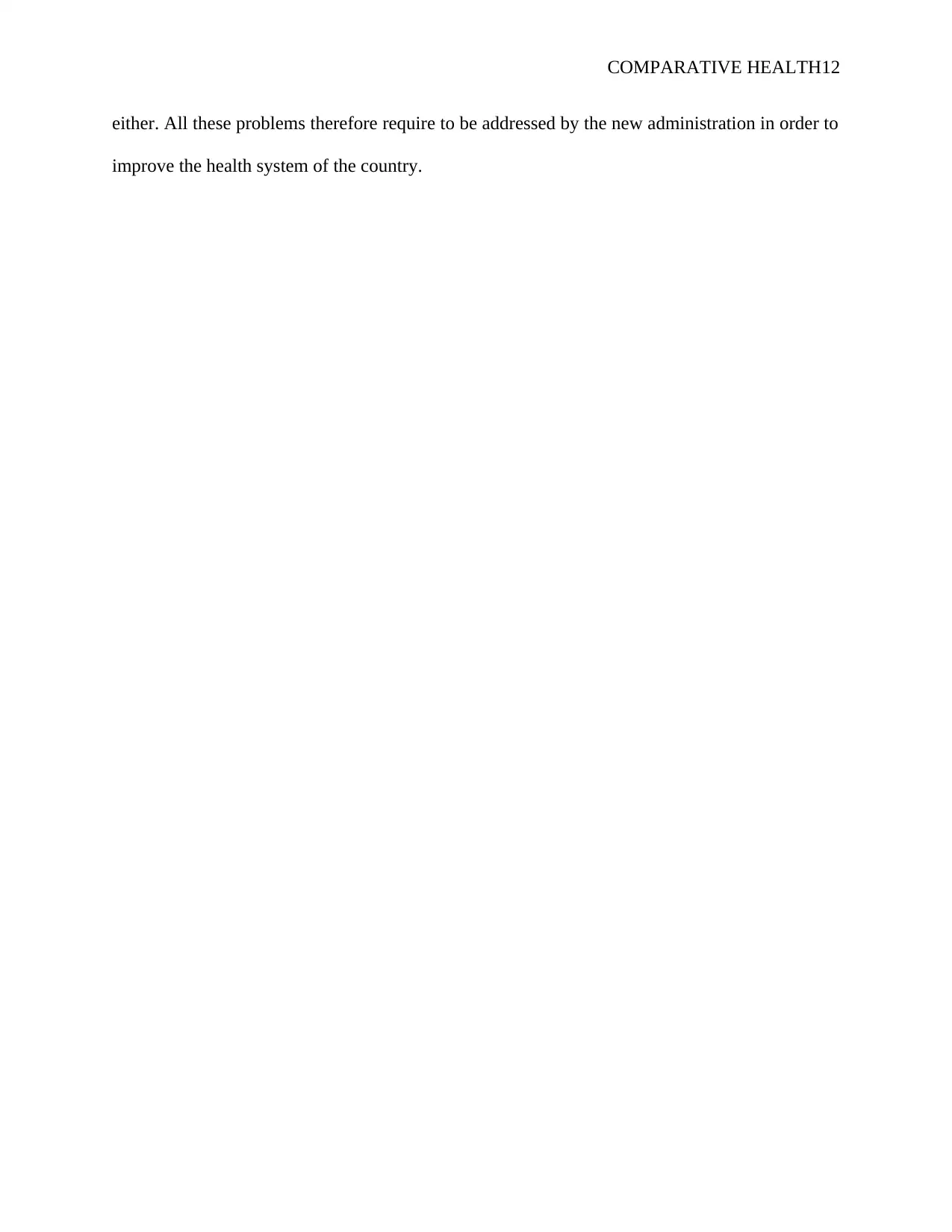
COMPARATIVE HEALTH12
either. All these problems therefore require to be addressed by the new administration in order to
improve the health system of the country.
either. All these problems therefore require to be addressed by the new administration in order to
improve the health system of the country.
⊘ This is a preview!⊘
Do you want full access?
Subscribe today to unlock all pages.

Trusted by 1+ million students worldwide
1 out of 14
Related Documents
Your All-in-One AI-Powered Toolkit for Academic Success.
+13062052269
info@desklib.com
Available 24*7 on WhatsApp / Email
![[object Object]](/_next/static/media/star-bottom.7253800d.svg)
Unlock your academic potential
Copyright © 2020–2025 A2Z Services. All Rights Reserved. Developed and managed by ZUCOL.




